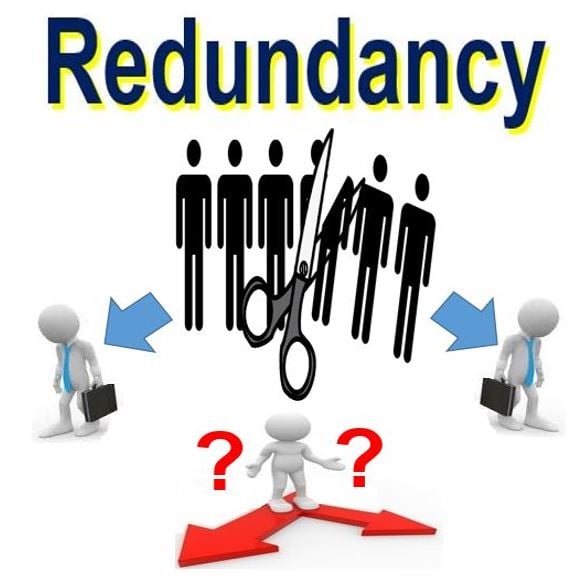Who Pays Redundancy Money? Comprehending Employer Duties in the UK
Who Pays Redundancy Money? Comprehending Employer Duties in the UK
Blog Article
Exploring the Interplay In Between Company Redundancy and Business Versatility for Future Growth
In the vibrant landscape of today's business globe, the intricate partnership between business redundancy and organizational flexibility emerges as an essential variable for sustained development and success. Companies commonly encounter the difficulty of striking a delicate equilibrium between preserving a degree of redundancy to alleviate risks and promoting adaptability to react swiftly to the ever-evolving market needs. This fragile interplay holds the crucial to not just surviving in stormy times but additionally flourishing when faced with unpredictability. As we explore the diverse measurements of this interaction, appealing understandings into exactly how companies browse these complexities to lead the way for future development wait for.
Relevance of Firm Redundancy
Firm redundancy is an essential aspect that enhances organizational durability and reduces operational dangers. By integrating redundancy steps within the organizational framework, business can much better stand up to unpredicted disturbances and changes in the organization atmosphere. Redundancy acts as a tactical buffer, enabling business to adapt and respond efficiently to unforeseen obstacles without endangering essential procedures.
One trick facet of the relevance of business redundancy is its function in guaranteeing continuity during times of dilemma. When faced with sudden changes or emergency situations, redundant systems, resources, or employees can action in to preserve crucial features and protect against widespread disruptions. This connection not only safeguards the firm's reputation and client trust however also lessens monetary losses and functional downtime.

Techniques for Organizational Flexibility

Developing adaptable business structures that allow for quick adjustments to market characteristics and consumer requirements is vital for remaining competitive in a quickly advancing atmosphere. By proactively determining potential disruptions and opportunities, organizations can proactively adjust and prosper in an ever-changing service landscape.
Balancing Redundancy and Versatility
Achieving an unified equilibrium between functional redundancy and organizational adaptability is critical in navigating the intricacies of a vibrant business environment. Striking the appropriate equilibrium in between redundancy and flexibility is a delicate process blog that requires a deep understanding of the company's goals, market dynamics, and threat resistance.
To achieve this equilibrium, business require to perform routine evaluations of their procedures to identify areas where redundancy is essential for risk navigate here reduction and where flexibility can drive innovation and development. Executing adaptable structures, cultivating a culture of constant understanding and renovation, and urging open communication throughout all degrees of the organization are essential methods to balance redundancy and versatility effectively. By lining up these two critical components, firms can place themselves for lasting growth and success in an ever-changing service landscape.
Case Studies on Adaptation Success
In checking out instances of effective business adaptation, it ends up being evident that the interplay between operational redundancy and adaptability is a defining element in shaping resilient organizations. A DVD rental service, Netflix demonstrated remarkable versatility by transitioning right into a streaming system when digitalization interrupted the industry. These situation research studies highlight the significance of functional redundancy combined with organizational flexibility in promoting lasting development and competition.
Structure Strength for Future Growth
Structure strength for future growth calls for a strategic alignment of operational processes with market characteristics and arising trends. Firms must adjust to transforming atmospheres by promoting a society of flexibility, innovation, and continual renovation.
In addition, redundancy pay if company goes bust cultivating strong connections with stakeholders, such as clients, staff members, providers, and the community, is important for weathering uncertainties and maintaining count on and support during turbulent times. Effective interaction and transparency play an essential function in building resilience, as they assist help with and line up expectations collaboration in browsing unpredictabilities.
Additionally, organizations need to focus on discovering and growth efforts to upskill workers and furnish them with the necessary tools to adapt to transforming scenarios. By purchasing their workforce, business can boost their flexibility and agility, eventually strengthening their resilience for lasting future growth.
Conclusion

In the dynamic landscape of today's service globe, the complex connection between firm redundancy and organizational adaptability arises as an important factor for continual development and success. Business often deal with the obstacle of striking a delicate balance in between maintaining a degree of redundancy to minimize risks and fostering adaptability to react swiftly to the ever-evolving market demands.To attain this equilibrium, business need to conduct routine assessments of their operations to recognize locations where redundancy is needed for risk mitigation and where flexibility can drive innovation and development.In verdict, the interaction in between business redundancy and business versatility is vital for future growth. Structure strength through a mix of redundancy and adaptability will certainly make certain that business are prepared for the obstacles of the future.
Report this page